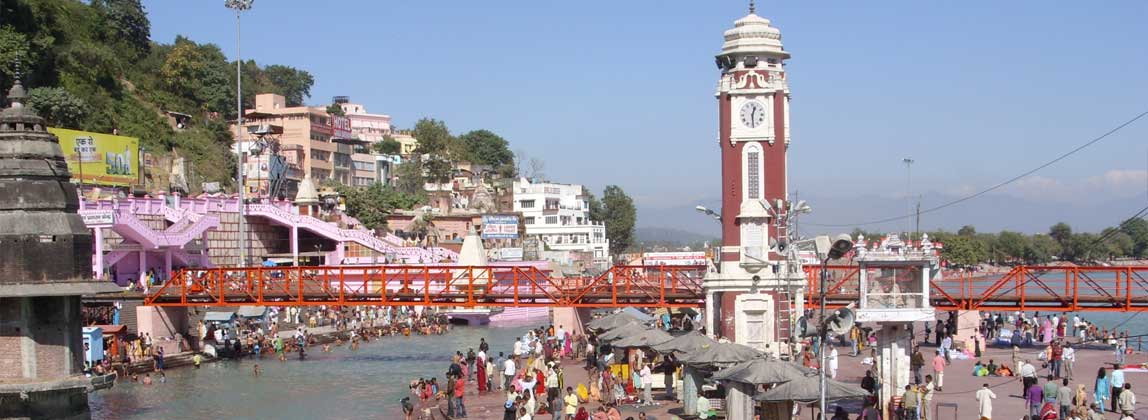


HARIDWAR - The name stands for Dwar of Hari or Gateway to God, 'Hari' meaning God and 'dwar' meaning gate.
The River Ganges, after flowing for 253 kilometres (157 mi) from its source at Gurumukhi at the edge of the Gangotri Glacier, enters the Indo-Gangetic Plains of North India for the first time at Haridwar.
Haridwar is regarded as one of the seven holiest places to Hindus. According to Hindu mythology, Haridwar is one among the four sites where drops of the elixir of immortality, Amrita, accidentally spilled over from the pitcher, in which it was being carried away by the celestial bird Garuda, after the Samudra manthan. The spot where the nectar fell is considered to be the Brahma Kund at Har-ki-Pauri (literally, "footsteps of the Lord," and symbolically the footprints of the Amrita), the most sacred ghat of Haridwar; thousands of devotees and pilgrims flock here during festivals or snan (Holy Bath) from all over India to take a holy dip. This act is considered to be the equivalent of washing away one's sins to attain Moksha (Salvation).
The Ganga Aarti, which is celebrated at 7 pm each night, is a spectacular sight, when the aarti ceremony is performed at all temples in Haridwar at the same instant. Hundreds throng to the ghats at Hari-ki-Pairi to participate in this ceremony. Offerings of lamps and flowers are made to the river immediately following this ceremony and it is a moving sight to watch hundreds of miniature lamps float along the river
One of the most ancient temples of India, Chandi Devi temple is located on the hill called the Neel Parvat, which is on the other side of the river Ganga. The temple was constructed by the King of Kashmir, Suchat Singh, in 1929 AD. Chandi Devi is a three km trek from the Chandi Ghat. One can either take a ropeway ride to the temple, or spend over 45 minutes to climb the steep steps leading to the temple. It is known to be a divine place where wishes are granted and fulfilled by Goddess Chandi.
Four kms from Haridwar is a town called Kankhal. Mythology says that the king of this place King Daksha Prajapati performed a yagya. His daughter, Sati was married to Lord Shiva. But Daksha was not happy with this marriage and did not invite Shiva-Sati in the Yagya.
But Sati came and was insulted by her father. She could not take the insult and burnt herself in the yagya kund. On hearing this followers of Shiva killed Daksha. But later Mahadeo (Shiva) brought Daksha to life. The Daksha temple is an attribute to this legend. This place is one of the five sacred places in Haridwar.
Har Ki Pauri is believed to be the exit point of the Ganges from the mountains and entry into the plains. Also known as Brahm Kund, this ghat was built by King Vikramaditya in memory of his brother Brithari who often meditated on the banks of river Ganga. History records an imprint of Lord Vishnu's foot on one of the stones present on the ghat, which is indicative of the name. An evening ritual (Aarti) performed by the priests on the banks of river Ganga is a highly enchanting and divine experience. Lamps are seen floating on the river, immersed after the ritual.
The fair is held ten days before Shivteras, during the Hindu months of Shravan & Phalgun.
This temple is located on top of a hill called the Bilwa Parvat. The temple can be reached by the rope way or one can take the normal trekking route to the top. The top of the hill gives you an excellent view of Haridwar. Goddess Mansa Devi, wife of the Nag King Vasuki, is believed to fulfill the wishes of devotees visiting her temple. To seek the blessings of the Goddess and get their wishes fulfilled, the devotees tie sacred threads on the sacred tree that stands proud in the temple premises.
One of the Siddhapeeths of Haridwar, and a vertex of the Siddhapeeth triangle formed between Mansa Devi, Chandi Devi and Maya Devi temples, this temple dates back to the eleventh century. It is believed that the heart and navel of Goddess Sati (first wife of Lord Shiva) fell in the premises of this ancient temple. Goddess Maya Devi, the Adhisthatri deity of Haridwar, is known to be an incarnation of power or shakti. A visit to Haridwar is incomplete without seeking the blessings of Goddess Maya Devi.
It is an ancient ashram famous for having hosted seven (sapt) sages (rishis), namely, Kashyapa, Vashisht, Atri, Vishwamitra, Jamadagi, Bharadwaja and Gautam. In order to avoid any disturbance to the seven sages meditating in the ashram, it is believed that river Ganga split herself into seven currents at this spot. Hence, this ashram is also referred to as Sapt Sarovar or seven streams.